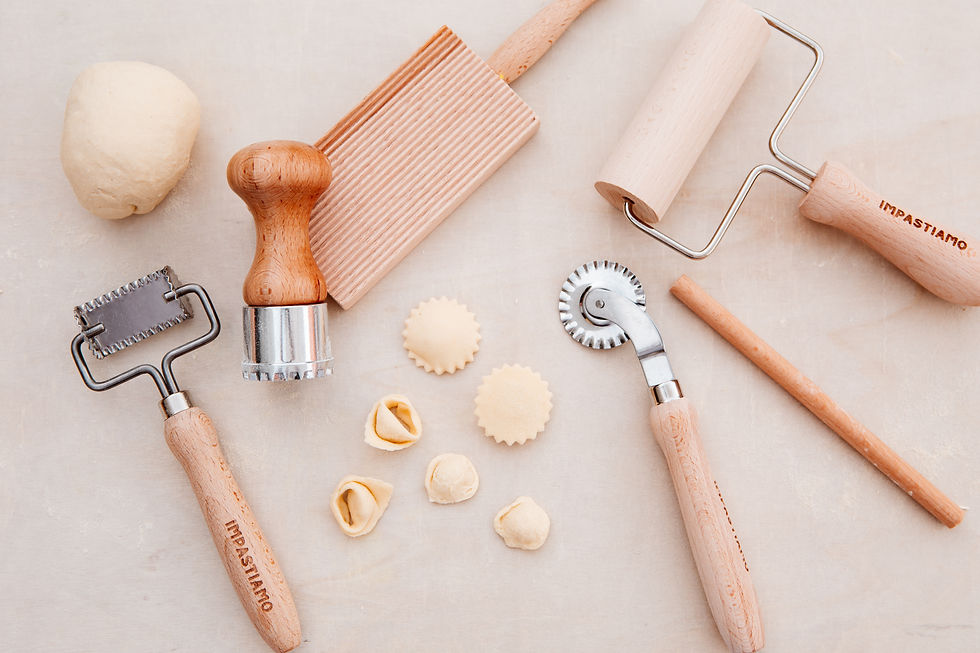Pasta vs. Noodles; What's the Difference?
- IMPASTIAMO Team

- Jan 10, 2022
- 3 min read
Updated: Mar 20, 2023
If you’re reading this article you’ve probably wondered at least once: is there a difference between Noodles and Pasta? The answer is, yes...there actually is a difference.
The difference is not only in the name; pasta and noodles are not simply two ways of calling the same dish.
They originated in two different regions of the world: noodles are from China, pasta is from Italy (and nope, Marco Polo did not introduce pasta to Italy in the 13th century, that has become one of the most debunked myths of our time).
They are made with different ingredients and methods and most importantly, pasta and noodles are used in different recipes.

What Makes a Noodle a Noodle?
Noodles originated in China and, given the size of the region, varying noodle traditions can be found there, too.
Wheat-based and hand-crafted noodles are a staple part of northern Chinese cuisine, while in the South noodles are usually thinner, made of rice and nowadays are factory produced. The northern Chinese tradition of wheat-based noodles is much more similar to the Italian tradition of pasta.
Noodles not only indicate a dish coming from a different region, made with specific ingredients and cooked according to local traditions, but also indicate a precise shape: the noodles are elongated and thin. Of course, you can find many variations (thicker or very long, soba noodles or udon), but the main shape does not change.
Noodles will never be served with the shape of a shell, a wheel, a butterfly or like macaroni.
So, What Defines Pasta?
Like we mentioned before, the main difference between pasta and noodles can be found in the ingredients: pasta is made of durum semolina, which is a lot coarser than typical flour. In northern Italy the pasta is much more full-bodied, because eggs are often added in addition to flour and water. The color changes, it becomes more yellow and very porous, this allows it to better absorb the sauce.
When we think about the word “pasta” we picture in our minds spaghetti (and we’ll soon tell you the reason why), but in Italy the word pasta literally defines a hundred of shapes and recipes.
According to Unione Italiana Food there are more than 300 shapes, the most loved and widespread are just ten. Lasagna is not just a delicious dish, but it is a shape of pasta itself (flat and rectangular), and it is in tenth position, on the first three spots there are: Fusilli, Penne rigate and… Spaghetti!
So, Pasta vs Noodles? What’s the Best Option?
There is not a unique answer for this question, it is relative and it depends on multiple factors. If you’re looking for a gluten free option or if you have dietary restrictions, then noodles made with rice flour are for you. If you’re thinking of preparing a meat or vegetarian ragù instead, then choose striped and short pasta, because in this way the sauce will penetrate deeper.
Pasta and Noodles have a lot of differences, yet they’re really similar and both delicious! For this reason you can easily substitute your stir-fry noodles with spaghetti. If you want to try traditional recipes, we advise you to pay attention to the origin of the dishes you will prepare, search the internet for recipes in the original language. It's true, it will take you more time to translate and convert the measurements, but the result will be worth it!




Ragdoll archers is perfect when you want something fast, silly, and surprisingly challenging.
Both are delicious by the way! A leading recruitment agencies in India, InsourceIndia also specializes in EOR services in India, and PEO Services in India enabling businesses to hire and manage talent compliantly across the country.
Technology in 2025 is marked by rapid advancements in AI, quantum computing, biotechnology, sustainable energy, and connectivity. Concerns over AI regulation, deepfakes, and job displacement remain prominent.
https://www.webupdatesdaily.com/
https://www.techreviewscorner.com/
https://www.webtechcrunch.com/
https://www.techbuzzinfo.com/
https://www.techbuzzard.com/
https://www.techreviewsdaily.com/
https://www.technologynewsclub.com/
https://www.techtrendsdaily.com/
https://www.cultfits.com/
https://www.trendyvouge.com/
https://www.techbuzzfeeds.com/
Thanks for this post! I always thought pasta and noodles were the same, but learning they come from different places and have unique ingredients was eye-opening. The Marco Polo myth part was especially interesting to read.
32win mang đến thế giới giải trí trực tuyến đẳng cấp với hơn 1000 tựa game hấp dẫn. Từ thể thao, casino, bắn cá đến xổ số, người chơi được trải nghiệm tốc độ cực nhanh và an toàn tuyệt đối. Chính sự chuyên nghiệp và uy tín đã giúp 32win app trở thành điểm đến hàng đầu cho cộng đồng bet thủ châu Á.